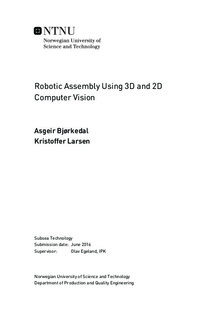Robotic Assembly Using 3D and 2D Computer Vision
Master thesis
Permanent lenke
http://hdl.handle.net/11250/2404420Utgivelsesdato
2016Metadata
Vis full innførselSamlinger
Sammendrag
The content of this thesis concerns the development and evaluation of a robotic cell used forautomated assembly. The automated assembly is made possible by a combination of an eye-inhand2D camera and a stationary 3D camera used to automatically detect objects. Computervision, kinematics and programming is the main topics of the thesis. Possible approaches toobject detection has been investigated and evaluated in terms of performance. The kinematicrelation between the cameras in the robotic cell and robotic manipulator movements has beendescribed. A functioning solution has been implemented in the robotic cell at the Departmentof Production and Quality Engineering laboratory.
Theory with significant importance to the developed solution is presented. The methods usedto achieve each part of the solution is anchored in theory and presented with the decisions and guidelines made throughout the project work in order to achieve the final solution.
Each part of the system is presented with associated results. The combination of these results yields a solution which proves that the methods developed to achieve automated assembly works as intended. Limitations, challenges and future possibilities and improvements for the solution is then discussed.
The results from the experiments presented in this thesis demonstrates the performance of thedeveloped system. The system fulfills the specifications defined in the problem description and is functioning as intended considering the instrumentation used.
